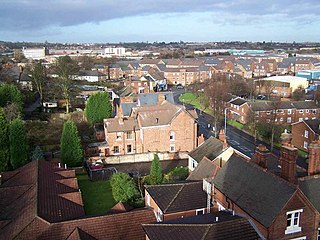Related Research Articles

The West Midlands is a metropolitan county and combined authority area in western-central England with a 2020 estimated population of 2,939,927, making it the second most populous county in England after Greater London. It appeared as a metropolitan county in 1974 after the passage of the Local Government Act 1972, to cover parts of Staffordshire, Worcestershire and Warwickshire. The county is a NUTS 2 region within the wider NUTS 1 region of the same name. It embraces seven metropolitan boroughs: the cities of Birmingham, Coventry and Wolverhampton, and the boroughs of Dudley, Sandwell, Solihull and Walsall.

Tipton is an industrial town in the West Midlands in England with a population of around 38,777 at the 2011 UK Census. It is located 16 kilometres (9.9 mi) northwest of Birmingham.
The West Midlands region straddles the historic borders between the counties of Warwickshire, Staffordshire in the north, and Worcestershire in the south.
The Miners' Federation of Great Britain (MFGB) was established after a meeting of local mining trade unions in Newport, Wales in 1888. The federation was formed to represent and co-ordinate the affairs of local and regional miners' unions in England, Scotland and Wales whose associations remained largely autonomous. At its peak, the federation represented nearly one million workers. It was reorganised into the National Union of Mineworkers in 1945.

The South Wales Miners' Federation (SWMF), nicknamed "The Fed", was a trade union for coal miners in South Wales. It survives as the South Wales Area of the National Union of Mineworkers.
The Midland Counties Miners' Federation was a trade union, representing coal miners in the West Midlands region of England.

Between the late 11th century and 1844, the English county of Shropshire had a large exclave within the present-day Black Country and surrounding area. This territory was gained from neighbouring Worcestershire, and the exclave's border corresponded with the medieval Manor of Hala. Shropshire (Detached) contained the townships of Halesowen, Oldbury, Warley Salop, Ridgacre, Hunnington, Romsley and Langley. The exceptions were Cradley, Lutley and Warley Wigorn, which were exclaves or enclaves still aligned with the original county. Bounded entirely by Staffordshire and Worcestershire, Hala was part of Brimstree hundred, and totally detached from the rest of Shropshire. Bridgnorth, the nearest town within the main body of Shropshire, is 16.8 miles (27.03 km) away from Halesowen, whilst the county town of Shrewsbury is 34.6 miles (55.62 km) away.
Samuel Henry Whitehouse was a British trade unionist.

The Somerset Miners' Association or Somersetshire Miners' Association was a coal mining trade union based in the Somerset coalfield, Somerset, England.
William Brown was a British coal miner who became a prominent trade unionist.
George Henry Jones was a British trade unionist and politician.
The Warwickshire Miners' Association was a trade union representing coal miners in the Warwickshire area of England.
The North Staffordshire Miners' Federation was a trade union representing miners in the area of Stoke-on-Trent, located in Staffordshire, in England.
George Henry Rowlinson was a British trade unionist.
The Cambrian Miners' Association, also known as the Rhondda District Miners' Association, was an early trade union representing coal miners in the Rhondda Valley, in Wales.
The Western Miners' Association was a trade union representing coal miners in parts of South Wales, centred on Neath.
The 2003–04 West Midlands (Regional) League season was the 104th in the history of the West Midlands (Regional) League, an English association football competition for semi-professional and amateur teams based in the West Midlands county, Shropshire, Herefordshire, Worcestershire and southern Staffordshire.
Henry Rust was a British trade unionist.
The Old Hill and Highley District Miners', Enginemen's and Surfacemen's Association, usually known as the Old Hill Miners' Association, was a trade union representing mineworkers in the Old Hill district of the West Midlands, in England.
The Shropshire Miners', Enginemen's and Surfacemen's Federation, often known as the Shropshire Miners' Association, was a trade union representing coal miners in Shropshire, in England.
References
- 1 2 3 4 5 Smethurst, John B.; Carter, Peter (June 2009). Historical Directory of Trade Unions. 6. Farnham: Ashgate Publishing. pp. 512–518. ISBN 9780754666837. LCCN 80-151653.
- ↑ Page Arnot, Robin (1949). The Miners. 1. London: George Allen & Unwin. pp. 106, 108, 390.
- ↑ Joyce, Patrick (1994). Visions of the People: Industrial England and the Question of Class, C.1848-1914. Cambridge: Cambridge University Press. p. 139. ISBN 0521447976.
- ↑ Barnsby, George J. (1998). Socialism in Birmingham and the Black Country, 1850-1939. Integrated Publishing Services. p. 72. ISBN 0905679105.
- ↑ National Union of Mineworkers, "Annual Conference 1946: Report of the National Executive Committee", p.98
- ↑ "Shropshire Miners' Reunion Service". Shropshire Caving and Mining Club. Retrieved 21 December 2020.